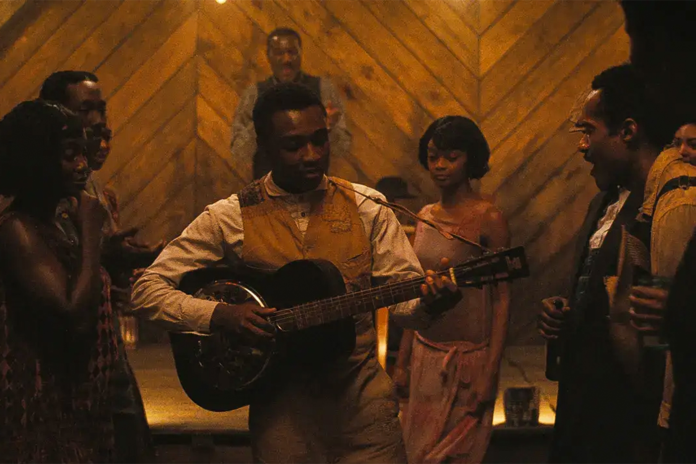Music is the backbone of Ryan Coogler’s vampire movie. A Northeastern expert explains how the film and Ludwig Göransson’s score push the boundaries of what music can do in a film.
“Sinners,” the latest blockbuster from “Black Panther” director Ryan Coogler, is a lot of things. It’s a historical drama about African Americans in 1930s Mississippi. It’s a romance. It’s a story about twins and the duality in all of us. Oh, and it’s a vampire movie.
But more than anything, “Sinners” is about music.
It’s a story of identical twin gangsters and their blues-playing cousin getting a juke joint on its feet while trying to fend off a vampiric threat and survive the night. But blues music provides the heartbeat.
The movie has been a box office sensation, and audiences have flocked to composer Ludwig Göransson’s music, which has topped the charts. Oscar prognosticators are already predicting Best Original Score and Best Original Song wins.
But what makes the music in “Sinners” stand out so much?
At the root of it is Göransson and his nearly ethnographic approach as a composer, says James Gutierrez, a composer and assistant teaching professor of music at Northeastern University. “Sinners” eventually tips into full on supernatural horror, but the story –– and music –– are grounded in the real cultural and musical traditions of the Mississippi Delta.
“He’s a composer who, unlike the traditional film composer, builds the sound off of archetypes that have been handed down for generations,” Gutierrez says. “His strength starts with a firm grounding in real musical contexts and traditions, but it takes flight in his ability to amplify not just their sounds, but their mythos: the sense of the timeless, unspoken and universal story buried somewhere between the notes.”
The score and the music that is played by characters like Miles Caton’s young blues singer Sammie “Preacher Boy” Moore are part of the fabric of the story. Even more than Göransson’s work on “Black Panther,” the music in “Sinners” is as much a part of the film’s world building as the actors, sets and costumes.
It’s a main character that is at the root of what Coogler wants to say about music, generational bonds and fractures and cultural appropriation. Göransson’s strengths as a genre bender meet Coogler’s history-spanning narrative in the musical centerpiece of the film, Gutierrez says.
“Sinners” opens by mentioning how some musicians are so powerful that their songs can pierce the veil between past, present and future, bringing together generations in a single moment. (Their songs can also attract things that go bump in the night, but Coogler saves that for later.)
Coogler visualizes that idea in a bravura piece of filmmaking. Preacher Boy starts to play and sing a classic-sounding Delta Blues number to the juke joint crowd, but soon the song builds and evolves, blending in performers and sounds of past and future genres, from traditional African drummers to hip-hop DJs.
“Where [Göransson’s] creativity shines is in the very subtle blending of these genres, like that dance scene, which is pretty seamless in bringing all this swirling music of different eras together, fading in and out,” Gutierrez says.
The juke joint scene is not just a way for Coogler and Göransson to show off, he adds. It’s an effective way of showing modern audiences how powerful –– and necessary –– the blues was, and is, for African Americans. The names Charley Patton, Robert Johnson and Son House might not be familiar to a lot of modern music listeners, but their sound is in the very soil of American music, from rock to pop to hip-hop. The genre, drawn from West African music and African American spirituals, is generations worth of pain and, despite it all, joy.
“You are ushered into it, too,” Gutierrez says of this scene. “It was making the blues known for what it actually did: captivate the American audience in the early 1900s. It’s grabbing the heart of the need to groove and the need to feel and the need to let go and join in.”
However, the blues is not the only music in “Sinners.” When the vampires finally arrive, their leader, the centuries-old Remmick, brings the musical tradition of his homeland, Ireland, into the picture. Before long, Remmick is Irish step dancing to “The Rocky Road to Dublin” amid his “community” of converted vampires.
It’s a jarring shift in both cinematic and musical genre, but one that works for what Coogler is trying to do, Gutierrez explains. Namely he’s drawing out the links between African and Irish Americans, their shared histories of oppression and “how their music helped them find a foothold of an economic hope.”
They also both faced off against a different kind of vampire.
“The first decades of ‘race records’ were rife with predatory deals that saw pioneering musicians like Mamie Smith, Lead Belly, Charley Patton and others scarcely compensated compared with the industry standard,” Gutierrez says. “It’s a similar story for early Irish American musicians, though it seems to a lesser degree. These deals, in essence, siphoned profits generated by vulnerable musicians of marginalized groups — their creative lifeblood — into the pockets (and presumably mouths) of an ancient and alluring force: insatiable, vampiric greed.”
The music in “Sinners” is its own reward, but, in that way, it’s also a vital music history lesson for one of the most influential genres in popular music. It just happens to be covered in blood.
Cody Mello-Klein is a Northeastern Global News reporter. Email him at c.mello-klein@northeastern.edu. Follow him on X/Twitter @Proelectioneer.
© 2025 Northeastern University
Is the music from ‘Sinners’ stuck in your head? A composer breaks down why it could be a modern classic – Northeastern Global News
RELATED ARTICLES
